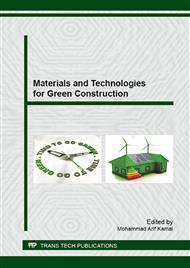[1]
D.S. Mintorogo, THE SUSTAINABLE ENERGY-SAVINGS SKYLIGHT IN SURABAYA-INDONESIA (Doctoral dissertation), (2007).
Google Scholar
[2]
K.M. Al-Obaidi, M. Ismail, A.M. Abdul Rahman. An innovative roofing system for tropical building interiors: Separating heat from useful visible light. International Journal of Energy & Environment, 2013; 4(1).
DOI: 10.1007/978-981-287-077-3_50
Google Scholar
[3]
K.M. Al-Obaidi, M. Ismail, A.M. Abdul Rahman. A study of the impact of environmental loads that penetrate a passive skylight roofing system in Malaysian buildings. Frontiers of Architectural Research, (2014).
DOI: 10.1016/j.foar.2014.03.004
Google Scholar
[4]
J. Carmody, Residential windows: A guide to new technologies and energy performance. WW Norton & Company, (2007).
Google Scholar
[5]
K.M. Al-Obaidi, M. Ismail, A.M. Abdul Rahman. A Review of Skylight Glazing Materials in Architectural Designs for a Better Indoor Environment. Modern Applied Science, 2013; 8(1), p.68.
DOI: 10.5539/mas.v8n1p68
Google Scholar
[6]
J. Yu, C. Yang, L. Tian. Low-energy envelope design of residential building in hot summer and cold winter zone in China. Energy and Buildings, 2008; 40(8), 1536-1546.
DOI: 10.1016/j.enbuild.2008.02.020
Google Scholar
[7]
T. Edward. Daylighting Design in Libraries. supported by the U.S. Institute of Museum and Library Services under the provisions of the Library Services and Technology Act, administered in California by the State Librarian. Retrieved May 13, 2014, from: http: /www. librisdesign. org.
Google Scholar
[8]
L. Heschong, , E.D. Resources. Skylighting Guidelines. Southern California Edison. James, G, (1998).
Google Scholar
[9]
D.S. Mintorogo. THE AQUATIC-POLYCARBONATE SKYLIGHT FOR SURABAYA INDONESIA. DIMENSI (JurnalTeknikArsitektur), 2007; 35(1), pp-100.
DOI: 10.9744/dimensi.35.1.100-106
Google Scholar
[10]
Bristol daylighting systems. Glazing materials used in plastic unit skylights. Retrieved May 13, 2014, from: http: /www. bristolite. com/Interfaces/glazing_materials. aspx#SH1.
Google Scholar
[11]
National Association of Rooflight Manufacturers. Natural Daylight Design ThroughRooflighting, Amendments. (2009). Retrieved May 13, 2014, from: http: /www. narm. org. uk/uploads/pdfs/J2335%20Natural%20Daylight%20Design. pdf.
Google Scholar
[12]
The American Architectural Manufacturer Association (AAMA. Glass or Plastic: The Question for Skylights. (2010). Retrieved May 13, 2014, from: http: /www. aamanet. org/news/1/10/52/products/312/glass-or-plastic-the-question-for-skylights.
Google Scholar
[13]
Queensland Skylight Installation. Glazing Materials for Skylights. (2013). Retrieved May 13, 2014, from: https: /www. qldskylights. com. au/Glazing-Materials-Skylights.
Google Scholar
[14]
A. Chel. Performance of skylight illuminance inside a dome shaped adobe house under composite climate at New Delhi (India): A typical zero energy passive house. Alexandria Engineering Journal. in press.
DOI: 10.1016/j.aej.2014.01.006
Google Scholar
[15]
I. Acosta, J. Navarro, J.J. Sendra. Daylighting design with lightscoop skylights: Towards an optimization of shape under overcast sky conditions. Energy and Buildings, 2013; 60, 232-238.
DOI: 10.1016/j.enbuild.2013.01.006
Google Scholar
[16]
I. Acosta, J. Navarro, J.J. Sendra. Towards an analysis of the performance of lightwell skylights under overcast sky conditions. Energy and Buildings, 2013; 64, 10-16.
DOI: 10.1016/j.enbuild.2013.04.009
Google Scholar
[17]
N.L.N. Ibrahim, K.A. Kosman, Z.M. Darus, A.S.M. Tazilan, A. Zaharim INNOVATIVE DAYLIGHTING: TOP APERTURE AND REFLECTIVE CEILING. Retrieved May 13, 2014, from: http: /fabserver. utm. my/download/ConferenceSemiar/ICCI2006S5PP03. pdf.
Google Scholar
[18]
J. Yunus, S.S. Ahmad, A. Zain-Ahmed. Analysing the Impact of Roof Obstructions on Daylight Levels in Atrium Buildings: Physical Scale Model Measurements under Real Sky Conditions. In Proceedings of International Conference on Environmental Science and Technology (ICEST 2011).
DOI: 10.1051/matecconf/201926601001
Google Scholar
[19]
H.S. Basher. The use of hybrid turbine ventilator to reduce air temperature under prismatic roofing. Master thesis, UniversitiSains Malaysia, (2012).
Google Scholar
[20]
Laws Relating to Housing and Construction in Malaysia. Section 4. (1998). Malaysia Uniform Building By-Law 1984, ACT 133. MDC Publishers Printers Sdn Bhd.
Google Scholar
[21]
A. Zain-Ahmed, K. Sopian, Z. ZainolAbidin, M.Y.H. Othman. The availability of daylight from tropical skies—a case study of Malaysia. Renewable Energy, 2002; 25(1), 21-30.
DOI: 10.1016/s0960-1481(00)00209-3
Google Scholar
[22]
Building Sector Energy Efficiency Project (BSEEP). Building Energy Efficiency Technical Guideline for Passive Design. Malaysia, (2013).
Google Scholar
[23]
Green Building Index. RESIDENTIAL NEW CONSTRUCTION (RNC). Retrieved May 13, 2014, from: http: /www. greenbuildingindex. org/Resources/GBI%20Tools/GBI%20Design%20Reference%20Guide%20-%20Residential%20New%20Construction%20(RNC)%20V1. 02. pdf.
Google Scholar
[24]
Department of Standards Malaysia. MS1525: 2007. Code of Practice on Energy Efficiency and Use of Renewable. Energy for Non-Residential Buildings. Malaysia.
Google Scholar
[25]
Integrated Environmental Solutions (IESVE). Home page. Retrieved May 13, 2014, from: http: /www. iesve. com.
Google Scholar
[26]
K.M. Al-Obaidi, M. Ismail, A.M. Abdul Rahman. Investigation of Passive Design Techniques for Pitched Roof Systems in the Tropical Region. Modern Applied Science, 2014; 8(3), P182.
DOI: 10.5539/mas.v8n3p182
Google Scholar


